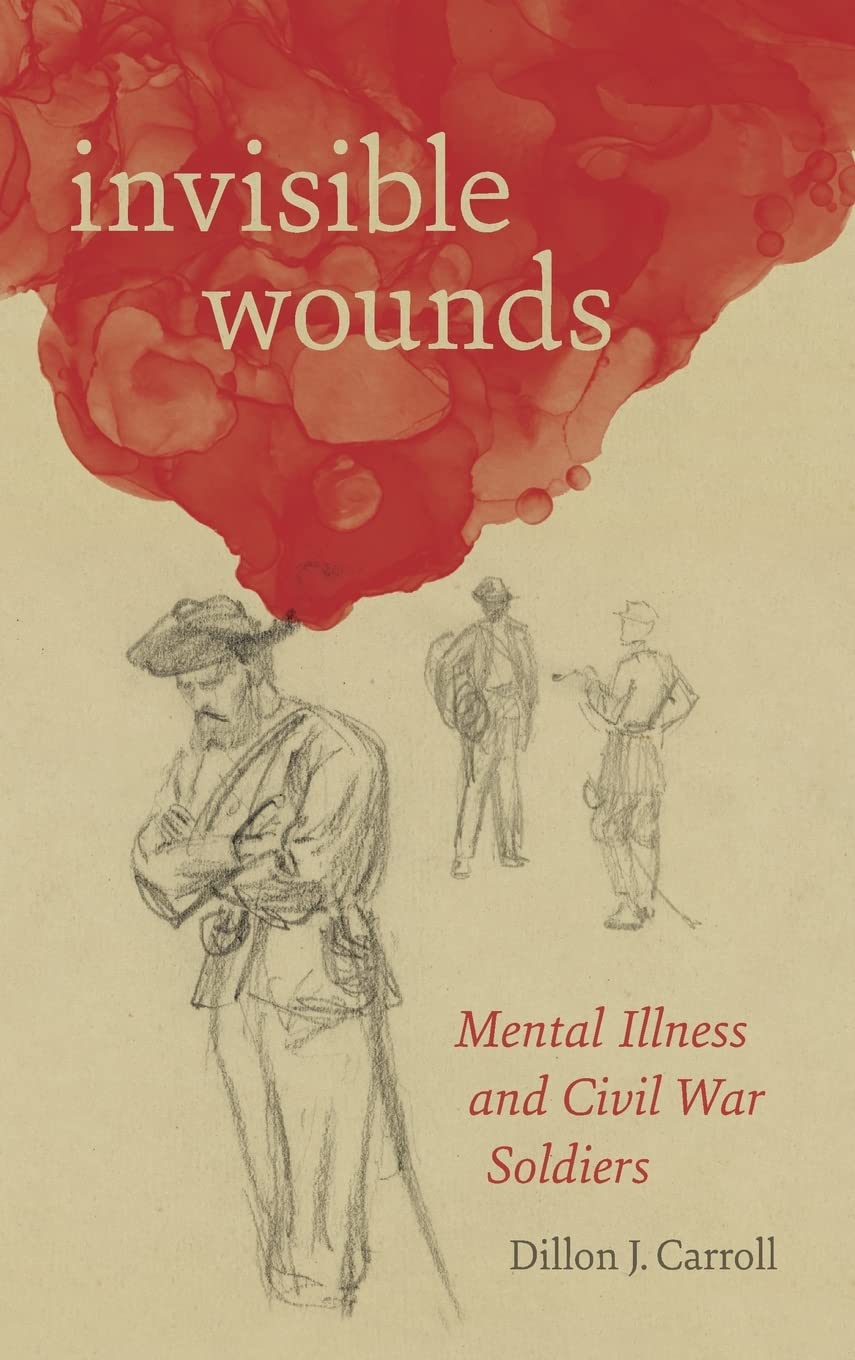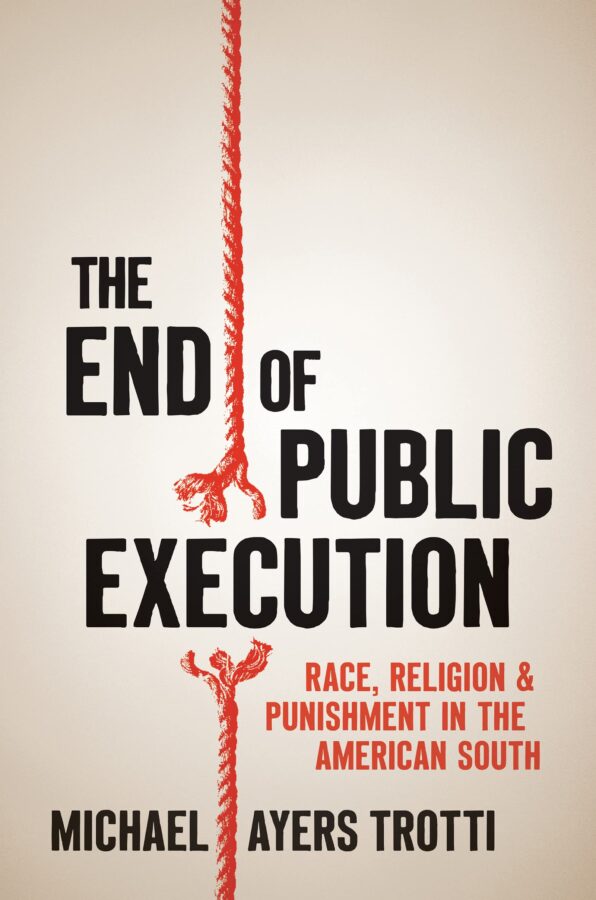
Invisible Wounds: Mental Illness and Civil War Soldiers by Dillon J. Carroll. Louisiana State University Press, 2021. 978-0-80716-9667. $45.00.
Historians of the Civil War have been fascinated by mental illness since the late 1990s, when the topic was first raised in earnest by the historian Eric T. Dean, Jr. Amidst a much broader scholarly reckoning with the Civil War’s destruction and ambivalent aftermath, several landmark studies appeared in the 2010s, illuminating various facets of mental illness among Civil War survivors. These studies included books by Jeffrey W. McClurken, Diane Miller Somerville, James Marten, Brian Matthew Jordan, and Sarah Handley-Cousins, among others. The result is that historians today widely recognize how the Civil War’s carnage and chaos ruined many survivors’ mental health. If anyone still doubts the existence of war-related mental illness among Civil War combatants, they should read Dillon J. Carroll’s Invisible Wounds: Mental Illness and Civil War Soldiers.
Carroll’s book reminds readers of the terrible toll exacted by the war upon the men who fought it. He also aims to probe beyond the causes of mental illness to suggest how soldiers and veterans tried to cope with, and even ward off, mental illness. As Carroll argues, “Civil War soldiers were sometimes emotionally and psychologically traumatized by the war,” a well-documented finding at this point. “Yet,” Carroll cautions,” these men were not as afflicted by emotional or psychological distress as historians have often believed. This was partly due to the coping mechanisms they [soldiers/veterans] employed…to deal with the aftermath of battle that reverberated in their minds” (2).
Carroll excavates numerous causes of mental illness and ways that combatants tried to mitigate mental illness. Invisible Wounds employs a wide-angle lens, first focusing on white and Black Union and Confederate soldiers, then following these men and their families into the postwar decades. Carroll also illuminates the much-needed perspective of the nineteenth-century psychiatrists—“alienists,” as Carroll calls them—who were responsible for providing last-ditch medical care for the mentally ill men the army or families could no longer manage. Comparative chapters juxtapose the experiences of white and Black Union and Confederate soldiers during the war and the Gilded Age, comparing experiences across regions, demographics, and eras. Veterans’ stories are complimented by chapters investigating the severe financial and emotional toll of caretaking on families and the asylums in which many veterans ended up institutionalized. Some 3,000 were admitted to St. Elizabeth’s in Washington, D.C., between 1861-1890, plus many more in state asylums in Virginia, South Carolina, Georgia and elsewhere. The chronologically long and thematically wide scope is a major strength of the book, since most previous studies have focused on specific regions.
Carroll’s findings about the causes and manifestations of mental illness among Civil War combatants are largely in line with previous studies, although his gifted prose conveys his research in haunting detail. Invisible Wounds reads well, which effectively drives home Carroll’s argument. Soldiers witnessed the horrible mutilation of messmates in battle, heard the screams of the wounded, and smelled the nauseating stench of the dead. Survivors’ nightmares were literally haunted by what they witnessed, Carroll argues. Couple these stressors with the emotional isolation of army life, he adds, and it’s no wonder that some soldiers went “insane,” a common label for mental illness in the Civil War era.
Evidence of insanity, Carroll argues, is readily apparent in the Civil War generation’s own words, written in letters, diaries, pension applications, and mental asylum records. Crucially, many asylum doctors (although certainly not all) attributed combatants’ mental illness directly to the war, especially in the war-torn South. Carroll concludes that the evidence of mental illness is so widespread in the historical record that uncovering traces of it does not require historians to utilize retrospective diagnosis, a controversial methodology. I suspect most readers will agree with Carroll, although at times he does use modern medical knowledge to fill in the gaps in his sources, and some readers might object. To his credit, however, Carroll clearly unpacks convoluted nineteenth-century ideas about mental illness and shows how the Civil War helped evolve these ideas over time from moral explanations of insanity to theories that stressed somatic origins.
What really sets Invisible Wounds apart is Carroll’s insight into how soldiers and veterans attempted to mitigate mental illness. Letters to and from home, faith and prayer, companionship of fellow soldiers, and strategic shirking (often seen by martial and medical authorities as “malingering”) provided emotional solace for white soldiers. Here, Carroll finds similarities with soldier studies by Kathryn Shively and James Broomall. Carroll even suggests that coping mechanisms kept many soldiers out of mental asylums, where the army and families often sent the most severely distressed men. This is a fair point, although it should be noted that nowhere near the majority of mentally ill war survivors would have ended up in asylums even without mitigating forces. These facilities were badly overcrowded, and with limited capacity they could only accommodate the worst of the worst cases.
In contrast, Carroll’s argument about how Black soldiers coped with mental illness falls short. Carroll claims that Black veterans were shielded from mental illness because of their zeal for combat, which stemmed from the desire to exact vengeance on former slaveholders and dismantle the institution of slavery. Yet Carroll’s evidence here is largely circumstantial, based mainly on the observation that few black veterans appeared in mental asylums like St. Elizabeth’s. But alternative explanations, such as discrimination and segregation in asylums and Black veterans’ distrust of white doctors, also provide plausible explanations for the low number Black patients in postwar asylums. Here, Carroll might have incorporated Martin Summers’s recent study of black patients at St. Elizabeth’s, Wendy Gonaver’s recent book on race in Virginia’s mental asylums, or Carole Emberton’s work on black soldiers and the meaning of violence. Worryingly, by asserting that black veterans largely did not, and could not, suffer from mental illness, there is risk of reinforcing nineteenth-century medical theories about racial difference, although that was certainly not the intent here.
Invisible Wounds also could have benefitted by expanding the cast of characters. Outside of asylums, which functioned like quasi-prisons, how did the state react to the Civil War’s mental health crisis? How did judges, juries, and sheriffs, so often thrust into contact with the mentally ill, factor into Carroll’s story? Likewise, did mentally ill veterans get caught up in jails, poorhouses, or soldiers’ homes and, if so, what happened to veterans there? Additionally, if Christianity provided solace for soldiers, did churches (especially Black churches, a bedrock of freedpeople’s postwar lives) play the same role? Many Americans also turned away from faith during the war. How did they fare with mental illness? These questions are left largely unaddressed, leaving room for future studies.
These issues notwithstanding, Invisible Wounds is a fascinating study that unequivocally illustrates the links between the Civil War and mental illness while expanding historians’ understanding of the lived experiences of mental health for soldiers and veterans.
Jonathan S. Jones is an assistant professor of history at Virginia Military Institute. His forthcoming book, “Opium Slavery: The Civil War, Veterans, and America’s First Opioid Crisis,” is under contract with University of North Carolina Press.

